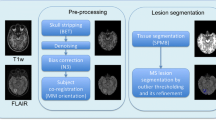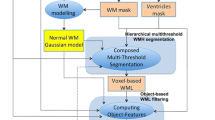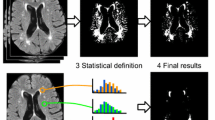Abstract
Objectives
Brain segmentation and volume estimation of grey matter (GM), white matter (WM) and cerebro-spinal fluid (CSF) are important for many neurological applications. Volumetric changes are observed in multiple sclerosis (MS), Alzheimer’s disease and dementia, and in normal aging. A novel method is presented to segment brain tissue based on quantitative magnetic resonance imaging (qMRI) of the longitudinal relaxation rate R1, the transverse relaxation rate R2 and the proton density, PD.
Methods
Previously reported qMRI values for WM, GM and CSF were used to define tissues and a Bloch simulation performed to investigate R1, R2 and PD for tissue mixtures in the presence of noise. Based on the simulations a lookup grid was constructed to relate tissue partial volume to the R1–R2–PD space. The method was validated in 10 healthy subjects. MRI data were acquired using six resolutions and three geometries.
Results
Repeatability for different resolutions was 3.2% for WM, 3.2% for GM, 1.0% for CSF and 2.2% for total brain volume. Repeatability for different geometries was 8.5% for WM, 9.4% for GM, 2.4% for CSF and 2.4% for total brain volume.
Conclusion
We propose a new robust qMRI-based approach which we demonstrate in a patient with MS.
Key Points
• A method for segmenting the brain and estimating tissue volume is presented
• This method measures white matter, grey matter, cerebrospinal fluid and remaining tissue
• The method calculates tissue fractions in voxel, thus accounting for partial volume
• Repeatability was 2.2% for total brain volume with imaging resolution <2.0 mm





Similar content being viewed by others
References
Rovira A, Leon A (2008) MR in the diagnosis and monitoring of multiple sclerosis: an overview. Eur J Radiol 67:409–414
Filippi M (2001) In-vivo tissue characterization of multiple sclerosis and other white matter diseases using magnetic resonance based techniques. J Neurol 248:1019–1029
Wu Y, Warfield SK, Tan IL et al (2006) Automated segmentation of multiple sclerosis lesion subtypes with multichannel MRI. Neuroimage 32:1205–1215
Simmons A, Westman E, Muehlboeck S et al (2009) MRI measures of Alzheimer’s disease and the AddNeuroMed study. Ann N Y Acad Sci 1180:47–55
Jack CR Jr, Slomkowski M, Gracon S et al (2003) MRI as a biomarker of disease progression in a therapeutic trial of milameline for AD. Neurology 60:253–260
Barnes J, Ourselin S, Fox NC (2009) Clinical application of measurement of hippocampal atrophy in degenerative dementias. Hippocampus 19:510–516
Guttmann CR, Jolesz FA, Kikinis R et al (1998) White matter changes with normal aging. Neurology 50:972–978
Andersen AH, Zhang Z, Avison MJ, Gash DM (2002) Automated segmentation of multispectral brain MR images. J Neurosci Methods 122:13–23
Alfano B, Brunetti A, Covelli EM et al (1997) Unsupervised, automated segmentation of the normal brain using a multispectral relaxometric magnetic resonance approach. Magn Reson Med 37:84–93
Jackson EF, Narayana PA, Falconer JC (1994) Reproducibility of nonparametric feature map segmentation for determination of normal human intracranial volumes with MR imaging data. J Magn Reson Imaging 4:692–700
Kikinis R, Shenton ME, Gerig G et al (1992) Routine quantitative analysis of brain and cerebrospinal fluid spaces with MR imaging. J Magn Reson Imaging 2:619–629
Vannier MW, Butterfield RL, Jordan D, Murphy WA, Levitt RG, Gado M (1985) Multispectral analysis of magnetic resonance images. Radiology 154:221–224
Shattuck DW, Sandor-Leahy SR, Schaper KA, Rottenberg DA, Leahy RM (2001) Magnetic resonance image tissue classification using a partial volume model. Neuroimage 13:856–876
Bonar DC, Schaper KA, Anderson JR, Rottenberg DA, Strother SC (1993) Graphical analysis of MR feature space for measurement of CSF, gray-matter, and white-matter volumes. J Comput Assist Tomogr 17:461–470
Choi HS, Haynor DR, Kim Y (1991) Partial volume tissue classification of multichannel magnetic resonance images-a mixel model. IEEE Trans Med Imaging 10:395–407
Warntjes JB, Dahlqvist O, Lundberg P (2007) Novel method for rapid, simultaneous T1, T2*, and proton density quantification. Magn Reson Med 57:528–537
Clare S, Jezzard P (2001) Rapid T(1) mapping using multislice echo planar imaging. Magn Reson Med 45:630–634
Deoni SC, Rutt BK, Peters TM (2003) Rapid combined T1 and T2 mapping using gradient recalled acquisition in the steady state. Magn Reson Med 49:515–526
Deoni SC, Peters TM, Rutt BK (2005) High-resolution T1 and T2 mapping of the brain in a clinically acceptable time with DESPOT1 and DESPOT2. Magn Reson Med 53:237–241
Neeb H, Zilles K, Shah NJ (2006) A new method for fast quantitative mapping of absolute water content in vivo. Neuroimage 31:1156–1168
Zhu DC, Penn RD (2005) Full-brain T1 mapping through inversion recovery fast spin echo imaging with time-efficient slice ordering. Magn Reson Med 54:725–731
Warntjes JB, Leinhard OD, West J, Lundberg P (2008) Rapid magnetic resonance quantification on the brain: optimization for clinical usage. Magn Reson Med 60:320–329
Breger RK, Wehrli FW, Charles HC, MacFall JR, Haughton VM (1986) Reproducibility of relaxation and spin-density parameters in phantoms and the human brain measured by MR imaging at 1.5 T. Magn Reson Med 3:649–662
Whittall KP, MacKay AL, Graeb DA, Nugent RA, Li DK, Paty DW (1997) In vivo measurement of T2 distributions and water contents in normal human brain. Magn Reson Med 37:34–43
Bottomley PA, Hardy CJ, Argersinger RE, Allen-Moore G (1987) A review of 1H nuclear magnetic resonance relaxation in pathology: are T1 and T2 diagnostic? Med Phys 14:1–37
Levesque IR, Pike GB (2009) Characterizing healthy and diseased white matter using quantitative magnetization transfer and multicomponent T(2) relaxometry: a unified view via a four-pool model. Magn Reson Med 62:1487–1496
Fletcher LM, Barsotti JB, Hornak JP (1993) A multispectral analysis of brain tissues. Magn Reson Med 29:623–630
Alfano B, Brunetti A, Ciarmiello A, Salvatore M (1992) Simultaneous display of multiple MR parameters with “quantitative magnetic color imaging”. J Comput Assist Tomogr 16:634–640
Bottomley PA, Foster TH, Argersinger RE, Pfeifer LM (1984) A review of normal tissue hydrogen NMR relaxation times and relaxation mechanisms from 1–100 MHz: dependence on tissue type, NMR frequency, temperature, species, excision, and age. Med Phys 11:425–448
Groeneveld RA, Meeden G (1984) Measuring skewness and kurtosis. The Statistician 33:9
Bland JM, Altman DG (1996) Measurement error. BMJ 313:744
Acknowledgements
We acknowledge the valuable contribution and skilful assistance of Yasemin Örter MSc, and Bo Jiang M.D., who reviewed the MS lesions detected as NoN on conventional T1- and T2-weighted images. In addition, we gratefully acknowledge the research funding and support for this project that was obtained from University Hospital Research Funds, CMIV, the Research Council of South-East Sweden (FORSS), the National Research Council (VR/NT) and the Knowledge Foundation (KK).
Author information
Authors and Affiliations
Corresponding author
Electronic supplementary material
Below is the link to the electronic supplementary material.
ESM 1
(DOC 60 kb)
Rights and permissions
About this article
Cite this article
West, J., Warntjes, J.B.M. & Lundberg, P. Novel whole brain segmentation and volume estimation using quantitative MRI. Eur Radiol 22, 998–1007 (2012). https://doi.org/10.1007/s00330-011-2336-7
Received:
Revised:
Accepted:
Published:
Issue Date:
DOI: https://doi.org/10.1007/s00330-011-2336-7




